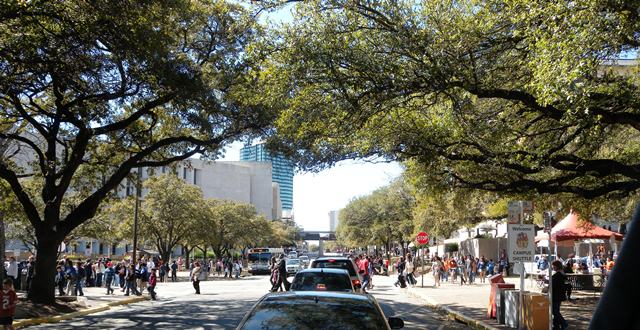‘Austin’ Category
» posted on Thursday, March 8th, 2012 by Linda Lou Burton
Choosing Austin
Linda Burton posting from Austin, Texas — Charles Maund Toyota, where everyone is family. http://charlesmaundtoyota7-px.rtrk.com/ That’s where Google directed me for the Scion’s first service appointment in a city unfamiliar to me. Felix took care of me with great efficiency and aplomb, paperwork done in a jiff, coffee in there maam, just have a seat and we’ll get right on it. I asked if I could meet the Manager, I wanted to tell him about the Journey Across America, and why I chose a Scion for the trip.
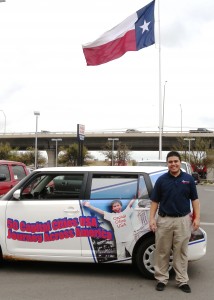 Felix walked across the parking lot with me, into the main office, knocked on the door of Charles Maund’s Vice President James DiMeo. “Come in, come in” Jim welcomed, listening to my story with appropriate nods, and smiles. “Austin is my first stop in visiting all 50 capital cities,” I explained, “and I really like this city. I can see myself living here.”
Felix walked across the parking lot with me, into the main office, knocked on the door of Charles Maund’s Vice President James DiMeo. “Come in, come in” Jim welcomed, listening to my story with appropriate nods, and smiles. “Austin is my first stop in visiting all 50 capital cities,” I explained, “and I really like this city. I can see myself living here.”
Big nod from Jim. » read more
» posted on Wednesday, March 7th, 2012 by Linda Lou Burton
Joyce Kilmer And Me
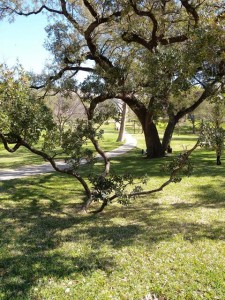 Linda Burton posting from Austin, Texas –– Austin trees have character. They don’t just pop up out of the ground and head for the sky. They meander, twist, and turn, taking their time to decide which way they want to grow. Kind of like the city itself. Interesting.
Linda Burton posting from Austin, Texas –– Austin trees have character. They don’t just pop up out of the ground and head for the sky. They meander, twist, and turn, taking their time to decide which way they want to grow. Kind of like the city itself. Interesting.
These distinctive trees, many of which grace the state capitol grounds, are live oaks, so called because the leaves remain green throughout the winter. Not actual evergreens, they drop their old leaves when the new spring green comes in. A true Texas tree, they are suited for Hill Country soil and even thrive in the coastal plains.
Seldom over 60 feet tall, their massive crowns may spread up to 120 feet. Known for their longevity and durability, live oaks can live 200 years or more in undisturbed landscapes. Strong wood characteristics, the spreading, low branching habit and a deep root system combine to make this species highly resistant to storm damage.
 This may sound like a lesson on gardening, but I’m not an arborist. It’s the poet in me that loves these trees. And Austinites must love them too, nearly every tree I’ve seen has a peaceful-looking person sitting under it. They even offer comfort when you’re stuck in an unforgiving traffic jam.
This may sound like a lesson on gardening, but I’m not an arborist. It’s the poet in me that loves these trees. And Austinites must love them too, nearly every tree I’ve seen has a peaceful-looking person sitting under it. They even offer comfort when you’re stuck in an unforgiving traffic jam.
» posted on Tuesday, March 6th, 2012 by Linda Lou Burton
Susie-Q on Bar-B-Q
 Linda Burton posting from Austin, Texas — Every Tom, Dick and Susie-Q in Texas loves barbecue. I googled Austin Barbecue to get some ideas for at least one “authentic Texas” meal. The “10 Best” listed Salt Lick Barbecue at the top. Thirty minutes outside of Austin, no credit cards, bring your own beer, a fireplace for chilly days. Second was Kreuz Market in Lockhart, no sauce, no sides, just belly up to the counter and order barbecued meat; it comes to you on butcher paper. The third listing was The County Line and that’s the one I chose, because, well, the tour guide said his daddy said it was the best barbecue he ever ate. A true word-of-mouth endorsement. » read more
Linda Burton posting from Austin, Texas — Every Tom, Dick and Susie-Q in Texas loves barbecue. I googled Austin Barbecue to get some ideas for at least one “authentic Texas” meal. The “10 Best” listed Salt Lick Barbecue at the top. Thirty minutes outside of Austin, no credit cards, bring your own beer, a fireplace for chilly days. Second was Kreuz Market in Lockhart, no sauce, no sides, just belly up to the counter and order barbecued meat; it comes to you on butcher paper. The third listing was The County Line and that’s the one I chose, because, well, the tour guide said his daddy said it was the best barbecue he ever ate. A true word-of-mouth endorsement. » read more
» posted on Monday, March 5th, 2012 by Linda Lou Burton
Whistle While You Work
Linda Burton posting from Austin, Texas — It was a noisy afternoon on the capitol grounds; visitors everywhere, traffic heavy on Congress Street, construction happening across 12th. Why is everyone whistling, I wondered. Whistling. Shrill. Almost like a musical instrument badly played; a stick pulled along a wire, tightly strung, then back again. The noise went shrilling up, then sliding down.
A black bird lit on the ground in front of me. More birds, in the trees, on the sidewalk, flying past my head, so fast that it was just a blur. A bossy whistle, nothing subtle there. A crow? Couldn’t be a crow, the sound was wrong. Couldn’t be a crow, the color was wrong too. This bird shimmered purple-ish on its head, its eyes were yellow, not black-crow black.
It took an internet search for me to find the name: GRACKLE. Southeast Texas is full of grackles, and the great-tailed variety is in love with Austin. Austin residents are not in accord on returning that love.
You don’t need a permit from the state of Texas to get rid of them, as they are not an endangered species by any stretch. But how? Shotgun blasts may send them scurrying, but they leave their gooey mark behind, and return to poop again. So you are left with the choice of tolerating them, or perhaps, creating grackle art.
A number of Austin artists have been inspired by the grackle; Consider the Grackle, an exhibit put together by Clayworks Studio/Gallery on E 6,th was so successful they were asked to stage it at Austin Bergstrom International Airport’s Stars of Austin Gallery, where it remains through March 31. http://www.clayworks.net/events.html
Poets have written about the grackle too. Wallace Stevens had a lovely line, “The grackles crack their throats of bone”; Ogden Nash was less lyrical in his Ode to The Grackle:
The grackle’s voice is less than mellow,
His heart is black, his eye is yellow,
He bullies more attractive birds
With hoodlum deeds and vulgar words,
And should a human interfere,
Attacks that human in the rear.
I cannot help but deem the grackle
An ornithological debacle.
Described by some as “machinery in need of lubrication,” if you hear a rapid-fire ki-ki-ki, repeated about 12 times, watch out; a grackle is about to come courting. Look for a black bird, about 18 inches long, with a bit of iridescent purple on his head, making rattling, squeaking, whistling noises, and definitely in charge of things. It’s a grackle, part of the soundtrack of Austin.
» posted on Sunday, March 4th, 2012 by Linda Lou Burton
The Balcones
 Linda Burton posting from Austin, Texas – Some say it’s where the south ends. On the east side of town is the rich black bottomland that once sustained the cotton economy of the old south; it’s an agricultural haven to this day. But in Austin, that farmland literally runs into a wall. That’s where it meets a bulwark of cracked and weathered rock, the beginning of the Texas Hill Country I’d heard about but couldn’t visualize before today. Now it’s clear to see; we’re west of town, parked at an overlook for a glimpse eastward towards the city; tall buildings rise high in the distance. The hills are sparse with vegetation, yet plentiful in high-end houses, perched and angled for the ultimate view. What once was considered “unproductive” from an agricultural standpoint is the high-dollar ticket for Texas real estate now. The demarcation line, that “wall,” is the Balcones Escarpment.
Linda Burton posting from Austin, Texas – Some say it’s where the south ends. On the east side of town is the rich black bottomland that once sustained the cotton economy of the old south; it’s an agricultural haven to this day. But in Austin, that farmland literally runs into a wall. That’s where it meets a bulwark of cracked and weathered rock, the beginning of the Texas Hill Country I’d heard about but couldn’t visualize before today. Now it’s clear to see; we’re west of town, parked at an overlook for a glimpse eastward towards the city; tall buildings rise high in the distance. The hills are sparse with vegetation, yet plentiful in high-end houses, perched and angled for the ultimate view. What once was considered “unproductive” from an agricultural standpoint is the high-dollar ticket for Texas real estate now. The demarcation line, that “wall,” is the Balcones Escarpment.
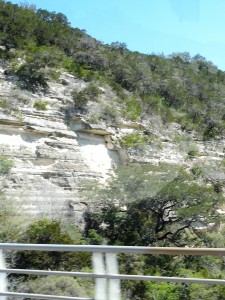 The Balcones Escarpment, which forms the eastern boundary of the Texas Hill Country and the western boundary of the Texas Coastal Plain, consists of cliffs and cliff-like structures. It is geology’s most fateful mark upon the surface of Texas, extending in a pronounced arc from Waco to Del Rio. The Balcones creates the Hill Country; the Hill Country sets the stage for the High Plains beyond. And that rich black bottomland ends here.
The Balcones Escarpment, which forms the eastern boundary of the Texas Hill Country and the western boundary of the Texas Coastal Plain, consists of cliffs and cliff-like structures. It is geology’s most fateful mark upon the surface of Texas, extending in a pronounced arc from Waco to Del Rio. The Balcones creates the Hill Country; the Hill Country sets the stage for the High Plains beyond. And that rich black bottomland ends here.
Our tour guide tells how Austin has expanded over the years. In the early 1950’s the land where we’re standing now was cheap. It was used for secluded weekends and church retreats; after all, it wasn’t fit for agriculture, it was more suitable for goats. The few neighbors were squatters, often called “cedar choppers” because they made their living cutting cedar trees for fence posts. By the 1970’s those squatters were being bought out, or forced to leave; thanks to rapid urban expansion.
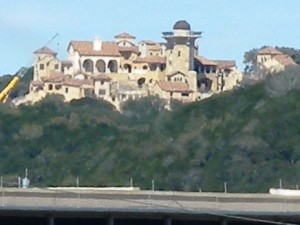 This is land that is barren and almost devoid of topsoil; the principal vegetation is cactus, cedar, and stunted live oaks. It may not be appealing to a farmer, who judges land by the depth and blackness of soil, but to the Central Texan looking for a homesite, Hill Country is definitely a prestige address. High-tech wealth is splattered hill to hill; Sandra Bullock, Lance Armstrong, and Matthew McConaughey are a few of the celebs who have houses tucked away in here, our guide proclaims.
This is land that is barren and almost devoid of topsoil; the principal vegetation is cactus, cedar, and stunted live oaks. It may not be appealing to a farmer, who judges land by the depth and blackness of soil, but to the Central Texan looking for a homesite, Hill Country is definitely a prestige address. High-tech wealth is splattered hill to hill; Sandra Bullock, Lance Armstrong, and Matthew McConaughey are a few of the celebs who have houses tucked away in here, our guide proclaims.
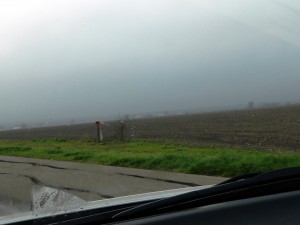 Urbanization causes controversy, in any city. In Austin, preservation of prime farmland is the main argument against urban sprawl eastward into the coastal plain. But conservation of wildlife habitat and protection of the Edwards Aquifer are reasons not to spread further west into the hills. As for earthquake hazards along the Balcones Fault Zone, geologists assure it isn’t active anymore; the risk for earthquakes is low.
Urbanization causes controversy, in any city. In Austin, preservation of prime farmland is the main argument against urban sprawl eastward into the coastal plain. But conservation of wildlife habitat and protection of the Edwards Aquifer are reasons not to spread further west into the hills. As for earthquake hazards along the Balcones Fault Zone, geologists assure it isn’t active anymore; the risk for earthquakes is low.
And then there’s that other consideration for the Austin resident – do you want to live in the south, or the west? The Balcones Escarpment is a clear and simple dividing point; or maybe it’s a unifying one, where south and west join together to make a really interesting place to live.
» posted on Saturday, March 3rd, 2012 by Linda Lou Burton
The Gumball Machine
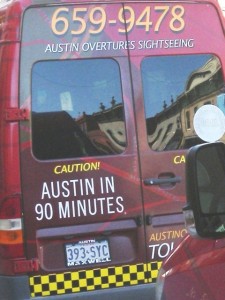 Linda Burton posting from Austin, Texas – “They should name it Austin Over-Tours,” I thought as I called to make my reservation. The Austin Overtures Sightseeing website promised I would “see Austin and the Hill Country in Air Conditioned Mercedes-Benz Comfort” for only $25. For that bargain price I didn’t mind having to drive downtown to meet them; the exercise would help me learn my way around the city. I parked at a meter by Brooks Brothers, just a few blocks off historic 6th Street (aka Pecan) and walked into the Visitor Center with time to spare. Postcards for sale, tshirts, books; big and little souvenirs of the Live Music Capital of the World and the Big Howdy
Linda Burton posting from Austin, Texas – “They should name it Austin Over-Tours,” I thought as I called to make my reservation. The Austin Overtures Sightseeing website promised I would “see Austin and the Hill Country in Air Conditioned Mercedes-Benz Comfort” for only $25. For that bargain price I didn’t mind having to drive downtown to meet them; the exercise would help me learn my way around the city. I parked at a meter by Brooks Brothers, just a few blocks off historic 6th Street (aka Pecan) and walked into the Visitor Center with time to spare. Postcards for sale, tshirts, books; big and little souvenirs of the Live Music Capital of the World and the Big Howdy 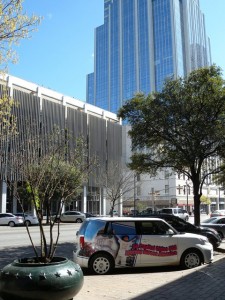 state of Texas. People lined up on a bench by the front to wait for the promised Mercedes-Benz ; there was quite a crowd. Our ticket-time was finally called; Tour Guide Philip (wearing a jacket of tweed) led us to the curb for our personal Pink Chariot Ride. “Can I please sit in the front with you?” I asked; permission granted. I wish I could remember everything to tell you. But Phillip rattled off so many facts and fictions about Austin, Texas that the inside of my head is like a giant gumball machine – filled with colorful, delicious, juicy bits. Which ones will the quarter bring down the slot? » read more
state of Texas. People lined up on a bench by the front to wait for the promised Mercedes-Benz ; there was quite a crowd. Our ticket-time was finally called; Tour Guide Philip (wearing a jacket of tweed) led us to the curb for our personal Pink Chariot Ride. “Can I please sit in the front with you?” I asked; permission granted. I wish I could remember everything to tell you. But Phillip rattled off so many facts and fictions about Austin, Texas that the inside of my head is like a giant gumball machine – filled with colorful, delicious, juicy bits. Which ones will the quarter bring down the slot? » read more
» posted on Friday, March 2nd, 2012 by Linda Lou Burton
The Ladies and the Bats
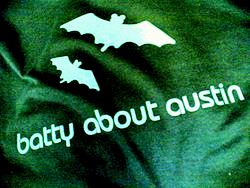 Linda Burton posting from Austin, Texas – Aw shucks, I’m going to miss the bats. Austin is famous for its music, its food, and a really odd thing that has always puzzled me. Part of Austin’s cultural identity is caught up in bats. And I don’t mean baseball bats, I mean the kind that fly around at night eating insects. The story goes like this: the Ann W Richards Congress Avenue Bridge (named after the 45th governor of the state of Texas), which crosses over Lady Bird Lake (named after the former First Lady of the United States and created by the Longhorn Dam on the Colorado River) is home to a large urban bat colony. These bats, on their nightly flying and eating quest, attract about 100,000 tourists annually and impact the city economically to the tune of $8
Linda Burton posting from Austin, Texas – Aw shucks, I’m going to miss the bats. Austin is famous for its music, its food, and a really odd thing that has always puzzled me. Part of Austin’s cultural identity is caught up in bats. And I don’t mean baseball bats, I mean the kind that fly around at night eating insects. The story goes like this: the Ann W Richards Congress Avenue Bridge (named after the 45th governor of the state of Texas), which crosses over Lady Bird Lake (named after the former First Lady of the United States and created by the Longhorn Dam on the Colorado River) is home to a large urban bat colony. These bats, on their nightly flying and eating quest, attract about 100,000 tourists annually and impact the city economically to the tune of $8  million a year. There are a million bats living under Ann Richard’s bridge over Lady Bird’s lake; which means there are more bats than people in Austin. It’s a spectacular sight, I’m told; gather on the bridge, or in boats, or on either side of the river just about dusk to watch. But alas, they haven’t come back to Austin from their winter vacation in Mexico yet; mid-March is a typical arrival time. Since I won’t get to see the little critters, I researched a few Bat Facts. » read more
million a year. There are a million bats living under Ann Richard’s bridge over Lady Bird’s lake; which means there are more bats than people in Austin. It’s a spectacular sight, I’m told; gather on the bridge, or in boats, or on either side of the river just about dusk to watch. But alas, they haven’t come back to Austin from their winter vacation in Mexico yet; mid-March is a typical arrival time. Since I won’t get to see the little critters, I researched a few Bat Facts. » read more

